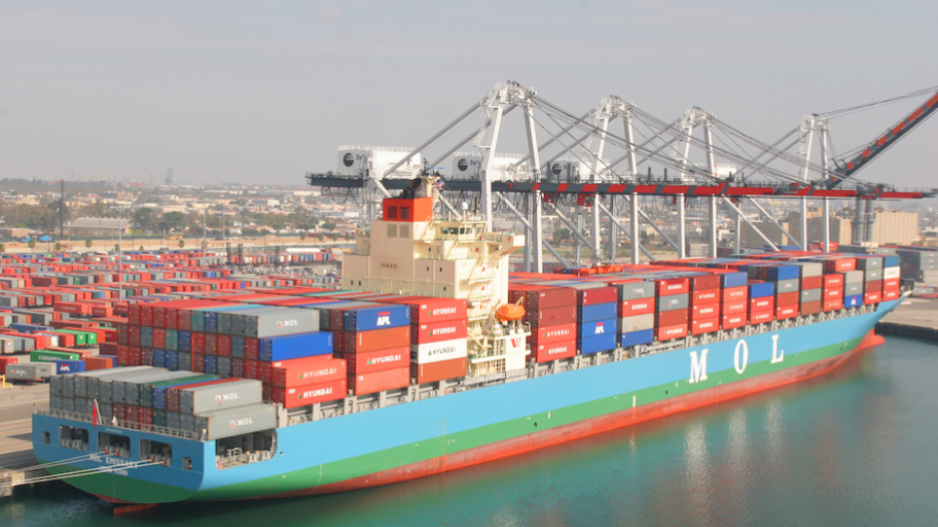The world’s largest lessor of container cargo ships is increasing its bet on the buoyancy of global container cargo in the pandemic economy.
Casino chips on the table this time for Vancouver-based Seaspan Corp. come in the form of an agreement with a major shipyard announced March 30 to build six new container ships to add to its growing fleet.
It’s not a bet for the faint of heart in the volatile global shipping sector.
Capacity of each ship will be 15,500 20-foot-equivalent units (TEUs). The six will provide a portion of the 580,000 TEUs the Atlas Corp. (NYSE:ATCO) subsidiary plans to add to its fleet to increase its container cargo capacity to 1.65 million TEUs.
Seaspan did not release the overall six-ship price tag, but container ships in the 14,000- to 16,000-TEU range would normally cost between US$100 million and US$200 million.
The company’s ship order is the latest step in its expansion ambitions.
Under new corporate leadership that took over Seaspan’s helm approximately four years ago, the company has invested a lot of container-ship capital in an aggressive growth plan.
Since 2017, when Gerry Wang retired as Seaspan CEO and David Sokol was appointed chairman of Seaspan’s board, it has added 71 new container ships and more than 890,000 TEUs; annual revenue has increased 71% to US$1.42 billion from US$831 million. At the end of 2020, Seaspan’s global fleet consisted of 127 ships.
The company also created Atlas in late 2019 and in early 2020 acquired APR Energy Ltd., the world’s largest lessor of mobile gas turbines, in an all-stock transaction valued at US$750 million.
During Atlas’ March 9 conference call for its 2020 financial results, company president and CEO Bing Chen noted that Seaspan’s new vessel growth “has added $5.9 billion of gross contracted cash flow to Seaspan within the last few months.”
Delivery of Seaspan’s six new ships is anticipated to begin in the second-half of 2023 and be completed by mid-2024.
The deal, which will be financed through cash on hand and additional debt, is also further indication of Seaspan’s optimism amidst the current trade turbulence created by continuing waves of the COVID-19 pandemic.
In an interview with BIV prior to his departure as Seaspan CFO at the end of September 2020, Ryan Courson said the company “has a very positive view on the long-term supply and demand dynamics of the container shipping space.”
He added that Seaspan’s container ship fleet, the world’s largest, “is going to be a key component of that supply and demand equilibrium.”
That optimism is shared by some analysts in the global shipping sector.
“As a person who has been accused of being Dr. Doom and Gloom for the past 10 years by every single industry participant, I’m weirdly optimistic on the volume side, especially the transpacific over the next year,” said Alan Murphy, the founder and CEO of Denmark’s Sea Intelligence.
Murphy, whose company generates global supply chain research, analysis and data, told BIV that his optimism is based on a fundamental change in the container shipping industry that occurred in 2020. In short: “shipping lines have perfected the art of short-term capacity management.”
That is largely the result of consolidation over the past five years and discipline within an industry where those factors have traditionally been in short supply.
He declined to comment on Seaspan or any other major player specifically in the global container shipping sector, but Murphy added that vessel orderings for major shipping lines have more to do with sustaining fleet size and competitiveness while matching demand growth than expanding those fleets.
As to the overall long-term outlook for global marine container freight, Murphy said the past year has been the best in at least 10 years.
“Now, I say we’re looking at at least five to 10 years of good use of the shipping lines, partly because things are looking better, but also because they are now consolidated and now so structured that even when volumes dry up, they can respond to it quickly.”
Container shipping overall did surprisingly well in 2020 and has been on a roll for the past four years.
As reported previously in BIV, the rebound in transpacific container traffic caught shippers, carriers and container terminals by surprise (“COVID’s Container Cargo Congestion Complications” – BIV issue 1634; February 22-28). Coupled with COVID-related labour shortages and operational disruptions and a 16% drop in trade in 2020’s first half followed by a 30% increase by year’s end, container traffic logjams occurred up and down North America’s west coast.
In an early April analysis, U.K.-based shipping consultancy Drewry noted that the year-end operating profits in the global container shipping sector totalled an estimated US$26 billion, “the best industry performance that Drewry has records for…”
That in turn has sparked a rapid rise in orders for new ships.
However, shipping lines remain wary about trade and business recovery.
Outlooks from major container shipping companies like A.P. Moller - Maersk (CPH:MAERSK-B) underscore the volatility of the pandemic economy around the world.
The 2020 annual report from the world’s largest container shipping company notes that the outlook for 2021 is subject to a host of uncertainties, including macro-economic conditions “COVID-19, bunker fuel prices and freight rates.”
During a March 10 ports and terminals market update webinar, Eleanor Hadland noted that the outlook for trade in 2021 and 2022 remains positive. But Drewry’s senior ports and terminals analyst added that “port congestion continues to disrupt market recovery, and empty container shortages will continue to hold back growth until system rebalance is attained.”
Drewry’s April analysis also pointed out that the rush to add new container shipping capacity in the form of new ships threatens to create future overcapacity that could again undermine the long-term fiscal health of container shipping lines. •
@timothyrenshaw




